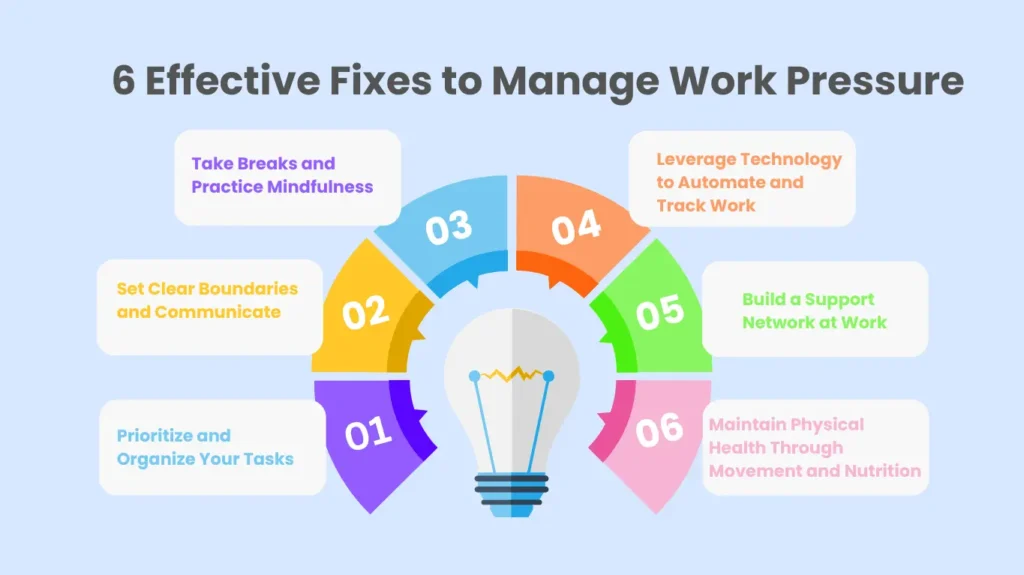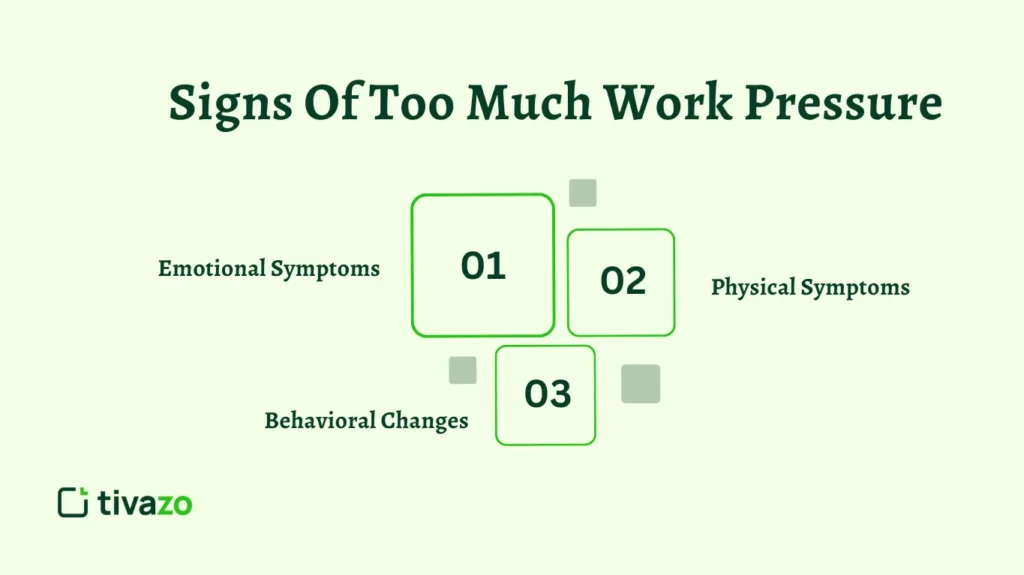Work pressure is a part of modern professional life that is impossible to avoid. Tight deadlines, concurrent projects, contentious relationships with co-workers, and more can build up pressure daily. Work pressure can build quickly and affect your health and wellness, physical and mental. Knowing how to manage work pressure effectively is critical to being productive and preventing you from burning out. In this post, you’ll find six effective, science-backed remedies to work pressure to help you reclaim your work life away from pressure without sacrificing personal health and happiness.
Key Highlights:
- Work Pressure Affects Health and Productivity
- Common Causes of Work Pressure in Today’s Workplace
- 6 Effective Fixes to Manage Work Pressure
- Signs You Might Be Experiencing Too Much Work Pressure
- The Role of Company Culture in Managing Work Pressure
What Is Work Pressure?
Work pressure is the stress and demands placed on employees to complete their jobs within time-limited timelines, often under stressful circumstances. Some pressure can help you work better, but when pressure feels overwhelming, it can create anxiety, mistakes, and decreased performance. The first step to developing a healthier workplace is to recognize the difference between normal stress and overwhelming work pressure.
How Work Pressure Affects Your Health and Productivity

When work pressure exists consistently, it can have a very detrimental impact on your physical and mental health. It can lead to physical symptoms such as headaches, fatigue, muscle tightness, and trouble sleeping.
These symptoms happen because prolonged stress activates the body’s fight or flight response, which leads to the release of Cortisol, a hormone that can hinder your immune system and create a greater susceptibility to other illnesses in the long term when elevated too long.
On a mental level, working under pressure or stress may increase your anxiety, irritability, and lack of focus. It can diminish your capacity to think, be creative, and problem-solving; thus, your overall satisfaction with the job experience will tend to diminish. When carried too far, work can feel more overwhelming.
Aside from productivity, workers experience problems meeting deadlines and producing quality work while under continuous pressure. Relentless pressure can lead to a higher incidence of mistakes, missed opportunities, and absenteeism due to illnesses associated with stress. Over time, if excessive work pressure is not dealt with, employees can experience burnout — a state of emotional, physical, and mental exhaustion that necessitates employees to step back from their responsibilities.
Common Causes of Work Pressure in Today’s Workplace
The idea of work pressure is influenced by a range of factors that frequently present themselves in many workplaces today. A major contributing factor to work pressure is workload and deadlines that go well beyond what might be considered reasonable. When people have way too much to accomplish within a certain time frame, of course, they are going to feel pressure from their work environment.
Added to this is the pressure of roles and responsibilities that are not well defined or a lack of clear support from managers or co-workers, and this becomes ambiguity at work. Also, people can experience work pressure when work and life are not balanced. Examples of this could include working excessively long hours regularly or always bringing work home and never truly disconnecting. Being constantly switched on completely wears people down to the point that they are exhausted and unable to perform to their fullest potential.
Finally, perceiving or experiencing change in the organizational context, or worrying that you could lose your job, adds a level of uncertainty to one’s work that makes it almost impossible to focus on what you do have control over at work. Each of these attributes by itself can elevate work pressure, but collectively, they are all prevalent today and play a major role in the work pressure many employees are likely to experience.
6 Effective Fixes to Manage Work Pressure
6 Effective Fixes to Manage Work Pressure are:

Fix 1 – Prioritize and Organize Your Tasks
A great way to relieve work pressure is to prioritize and plan your tasks to focus on what matters most. Tools such as the Eisenhower Matrix can help you categorize tasks into important and unimportant tasks and separately into urgent and non-urgent tasks, then push to the forefront the things that matter most. Also with a method like the Pomodoro Technique, which breaks work down into focused intervals (typically around 25 minutes followed by a short break), can help you remain focused and limit feelings of anxiety or burnout. By more deliberately planning your workload, you can relieve feelings of overwhelm, stay on top of deadlines, and improve your overall productivity.
Fix 2 – Set Clear Boundaries and Communicate
Establishing boundaries with work schedules and work responsibilities is a critical part of managing work pressure. Having these boundaries defined helps you set when you are available for work and when you are not, preventing potential overwork and burnout.
Along with this, ensuring you are communicating your boundaries with your managers and your coworkers is equally important. Having transparent communication around what your capacity is and where your workload is helps to establish and manage expectations, which will ensure that there is an understanding of your limits.
The stars need to align to take on additional work. Leaning into “no” when correctly applied, or negotiating deadlines, is a key part of managing too many tasks at once.
Fix 3 – Take Breaks and Practice Mindfulness
Regular breaks during your workday are important for your ability to focus and to alleviate stress. Short breaks allow your brain time to relax, recover, and sustain increased productivity over time. Mindfulness through deep breathing, meditation, or simple body awareness activities can further alleviate stress and anxiety. Mindfulness can help you stay in the present, calm your nervous system, and improve your emotional resilience to pressure from work.
Fix 4 – Leverage Technology to Automate and Track Work
Integrating technology in managing work pressure may be life-changing. Timekeeping and tracking applications help visualize how you are spending your work hours. Sure, it may help show what activities are wasting your time and help you plan your day. Automation supports reducing manual repetitive tasks or busy work, so you can save and redirect your mental energy to meaningful work.
Use technology to help structure your workflow and keep tabs on your productivity to keep you organized and limit that overwhelmed feeling.
Fix 5 – Build a Support Network at Work
Creating a good support network at work will help you cope with work pressure. Supportive work colleagues can help you with work tasks, share your workload with you, and fully provide emotional support when you feel stressed. Developing good relationships with colleagues develops a sense of belonging and reduces isolation.
Relational work creates spaces for communication, so it is much easier to problem solve together, rather than having to deal with the challenges alone.
Fix 6 – Maintain Physical Health Through Movement and Nutrition
Your physical health has direct implications for your ability to manage stress. Regular physical activity – even stretching or a walk- brings about natural endorphins, which are natural mood boosters, providing stress relief and energy.
A good diet and nutrition fuel your brain and body with the right nutrients and minerals, which maintain focus and resilience. Hydration and sleep are also factors in maintaining mental and physical stamina while under work pressure.
The Role of Leadership in Managing Work Pressure
There is much that managers and team leaders can do to recognize when employees are under undue work stress and take helpful actions to take. First and foremost, an open, honest communication style, coupled with a sense of safety, allows team members to feel comfortable disclosing their struggles and concerns about workload. Next, having realistic expectations about deadlines and deliverables goes a long way in limiting unreasonable expectations that lead to stress.
In addition, leaders valuing and promoting a culture of support in the workplace, including a balance between work and life, recognizing employee accomplishments, and providing environments conducive to mental health, promote less pressure at work. Not only can strong leadership with empathy and good direction support their employees to be less stressed, but it can also ultimately improve team morale and engagement, and productivity.
When to Seek Professional Help
While everyone has experienced work pressure at some point in their career, it becomes problematic when pressure has a lasting and detrimental impact on your life and overall well-being. If you are dealing with continued anxiety, ongoing worry, and ongoing hardships with sleep as a result of work stress, these could be good indicators that you need professional support. Other indicators include experiencing emotional depletion, feeling overwhelmed to the point of burnout, and not being able to find or maintain your motivation and focus despite your best efforts.
Professional help is an avenue for counselors, therapists, or professional coaches to work with you to identify personalized tactics for how to deal with stress, enhance mental well-being, and develop resilience. Using professional help when stress first does damage to your life allows you to not only avoid worsening symptoms but also encourages recovery quickly and ultimately find a return to control and balance in your personal and working life.
Signs You Might Be Experiencing Too Much Work Pressure

- Emotional Symptoms:
- Constant anxiety or worry,
- Frequent irritability or mood swings
- Physical Symptoms:
- Constant headaches or muscle tension
- Constant fatigue or low energy
- Problems falling asleep or staying asleep
- Behavioral Changes:
- Procrastinating or avoiding things
- Withdrawing from work colleagues, avoiding social events, or meetings
- A decrease in your productivity or quality of work
Strategies to Build Resilience Against Work Pressure
Although it is important to learn to manage work pressure over time, developing and establishing resilience is a necessary first step toward building up to manage pressure more effectively over time. To do this, techniques such as mindfulness or meditation can help to clear the mind, enhance concentration, reduce stress, and provide the opportunity to bring awareness to the present. Constructive self-talk and cognitive reframing will help an individual challenge negative thought patterns and recast challenges from a more positive and constructive perspective.
Experimenting with stress management techniques relative to breathing, journaling, or other healthy ways to process emotions will help relieve tension. Adopting a growth mindset, e.g., setbacks are opportunities to learn and enhance performance, will foster resilience and improve your abilities to deal with the pressure of work on the job with increased confidence and flexibility.
Building resilience helps you adapt more effectively to stress and bounce back faster from stressful situations in the workplace. Utilizing mindfulness or meditation on a regular basis re-trains your brain to respond to pressure with calmness and maintain equilibrium. Positive self-talk replaces self-doubt with messages of encouragement, which helps bolster your self-confidence so you can accomplish the hardest tasks.
Stress management strategies like deep breathing techniques or journaling offer practical strategies to leverage and release pent-up tensions before they become unwieldy. Having a growth mindset gives you the confidence to use challenges for the advantage of personal growth instead of threats, building your ability to persevere on the job and think constructively about work pressures you face.
The Role of Company Culture in Managing Work Pressure
Work pressure is not an issue that just rests on an individual’s shoulders— it is heavily influenced by the culture and surroundings in which employees find themselves. Naturally, the highest level of influence is placed on company leaders. When leaders provide support and demonstrate genuine empathy towards employees, they build trust and develop open lines of communication.
Organizations that communicate to employees that unnecessary work pressure doesn’t need to happen by supporting policies that establish realistic deadlines, provide flexibility in working hours, offer mental health days, etc., create a low-pressure foundation. When channels for open communication and pathways for employees to seek help (e.g., employee assistance programs) are established, a situation arises where employees can communicate when they feel overwhelmed and ask for help.
Companies that foster open, positive workplace cultures understand the importance placed on employee well-being instead of a priority placed on productivity, resulting in lower levels of stress, increased job satisfaction, and greater overall performance.
Conclusion
In today’s demanding workplaces, work pressure management is critical to maintaining your health and continued productivity. By prioritizing tasks, setting boundaries on your work, using technology such as time management and automation tools, and going for regular exercise to support your physical and mental health, you can achieve a more balanced and enjoyable work life. These six science-based strategies provide action-oriented steps to lower stress, boost focus, and help build resilience to persistent stress.
It is important to recognize that work pressure management is not a one-off solution, but rather an ongoing cycle of awareness and adjustment. Start putting these techniques into practice today to take back control of your work time, stave off burnout, and achieve sustainable success as both a professional and individual.




